22 January, 2003
Hello from a very blustery McMurdo. It’s Linda Welzenbach reporting. Andy
and the rest of the male contingent managed to sneak out on a late Sunday
flight to Christchurch on a C-141. A very lucky escape as within just a few
hours we were enveloped in a blizzard. Condition 1 was listed on the
weather channel for all areas outside of McMurdo station and Scott Base,
which means absolutely no travel except in an emergency, and even then
requires an escort by Search and Rescue personnel. McMurdo itself was
Condition 2, which allows foot travel. Some events are not weather
dependent, so at 7:45 last night, we helped Dean with Bag Drag, the required
weighing in for a Tuesday flight north, which we knew would be cancelled.
Getting outside was actually refreshing, so we made the best running around
in winds gusting to 50 knots, and glasses completely covered in wet snow.
We did manage to have a little bit of photographic fun as you can see below…
Now that we have finished collecting, we thought it might be a good idea to
explain what happens to the meteorites once they leave Antarctica. They are
currently held in a freezer until the boat arrives that will carry them
frozen back to the U.S. The estimated date of arrival is the 8th of March,
at which point they will be flown to NASA’s Johnson Space Center in Houston.
As many of you will know, that is also where the Lunar Rocks were initially
processed and where they still live. This made it pretty easy for the
ANSMET founders to decide who would be the best custodian and handler of the
meteorites collected.
It should be no surprise that the meteorites are unpacked in the same
cabinets used to process the lunar rocks. These cabinets are filled with
Nitrogen gas, which is used to dry out any ice or snow that adhered to the
meteorites when they were collected. The gas also keeps out moisture,
salts, metals and organic compounds for as long as the meteorites remain
stored in that environment, preserving them for the future. After they’ve
been thawed and dried, they are weighed, described, photographed and given a
name.
So what’s in a meteorite name? All the worlds’ meteorites are named for the
local geographic landmark or township from which they are found. While
there are numerous Antarctic locations (almost 40!) naming the hundreds of
meteorites found at each would be difficult. Yet it is actually a very
simple system of letters and numbers that is used to keep track of all those
pesky meteorites. A typical Antarctic meteorite will have a name that looks
like this: BTN 00300, where the first three letters are the abbreviation of
the location (in this case Bates Nuntak.) The first two numbers are the
year it was collected (2000-but we only use the last two digits), and the
last three digits refer to the specimen number among all the meteorites
collected in that year.
After NASA has curated and cataloged the meteorite, they remove a few grams
and send it to me at the Smithsonian for identification and description.
When I receive the package from NASA, I conduct a macroscopic investigation
of the chips, separating out the unique chondrites, achondrites and irons
for in-depth analyses, while the rest of the ordinary chondrites are set
aside to be classified using standard optical mineralogy methods.
First, let’s look at what we do with those we decide require in-depth
analyses. These will go to our Polished Thin Section preparator, who will
take the chip, impregnate it with epoxy, glue it to a * inch round glass
slide, cut off most of the sample (the remainder is used to make future
thin-sections) and grind the remainder down the a thickness of 30-40 microns
(please folks, don’t try this at home, it’s a job for a professional!) At
this thickness you can see through the rock. When placed under a microscope,
you see a kaleidoscopic view of all of the individual minerals, how they are
connected to each other, and using an Electron Microprobe, find out the
chemical make-up of the individual mineral crystals. We can also describe
what kind of textures and structures are present.
For the ordinary chondrites, we actually remove a small piece from the chip
to make into a powder for classification using a petrographic microscope.
The process is relatively simple, but takes 5-7 minutes for each sample
(Imagine how long it would take to process more than 800 from this
season….). We grind the tiny sample into a powder (tiny mineral
crystals,) and immerse them in special optical oils on a glass slide. Our
observation of optical effects that occur between the crystal and the oil
tell us something about the iron content of the mineral, which then can be
applied to a system of classifying ordinary chondrites.
Now that all the meteorites are classified, we send the data back to JSC,
where it will be published in the Antarctic Meteorite Newsletter. Published
twice per year, scientists all over the globe will read it to find out about
all the new meteorite samples now available for research. NASA’s
stewardship goes beyond it’s initial handling of the meteorites collected,
they also handle scientists requests for samples, up to 75 per year for an
average of 600 samples. In the 26 years the program has been operating.
over 300 investigators from 24 nations have received over 10,000 samples.
In addition to NASA’s curatorial duties, the National Science Foundation
sponsors a committee of meteorite scientists, called the Meteorite Working
Group, who aid NASA by assisting with sample allocations for meteorites
whose rarity and limited quantity need to be preserved for the future.
What NASA doesn’t have is unlimited space, and here is where the Smithsonian
becomes involved again. After a certain period of reduced activity, certain
meteorites are transferred to the Smithsonian. As committed to preservation
as NASA, the Smithsonian modeled its storage exactly like the Lunar and
Meteorite facility at the Johnson Space Center, located out at our Museum
Support Center in Suitland, MD.
Besides supporting a continually active sample allocation program, we are
parcticipate in extensive outreach programs, such as exhibition of Antarctic
meteorites, not only at the National Museum of Natural History, but all over
the world, including at the Antarctic Treaty Conference scheduled for June
2003 in Madrid, Spain.
The next time you see an Antarctic meteorite, you will have the soup to nuts
understanding of what it took to get it from the ice, to the world. I’m so
glad to be a part of the world of Antarctic meteorites, and I’m pleased to
be able to share it with you.
For more information, you can go to the following websites:
http://www-curator.jsc.nasa.gov/curator/antmet/antmet.htm
http://www.cwru.edu/affil/ansmet/
http://www.nmnh.si.edu/minsci/
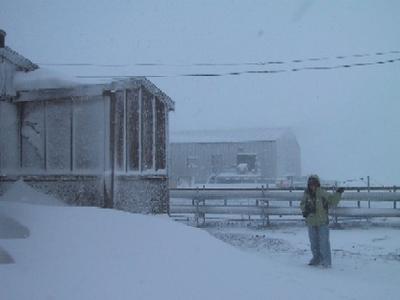
Blizzard in McMurdo! Blowing snow drifts create a scenic view along one of the few wooden buildings in McMurdo. Linda Welzenbach and Cady Coleman enjoyed the snow until it coated cameras and glasses! (photo by Cady Coleman)
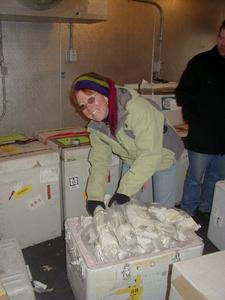
Linda Welzenbach repacks meteorites collected from MacAlpine hills. The freezer is colder than outside! (photo by Nancy Chabot)
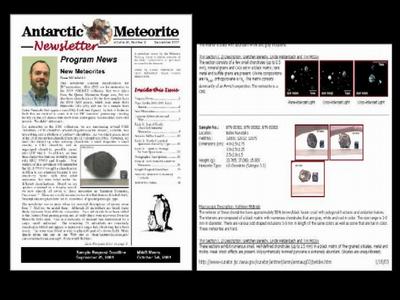
The Antarctic meteorite newsletter is published twice a year and contains descriptions of new meteorites recovered by ANSMET.
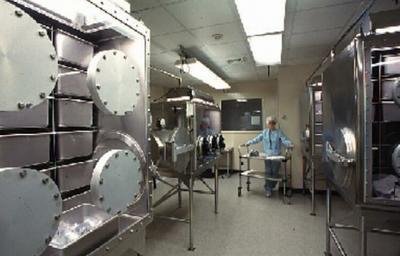
Linda Welzenbach is putting away new Antarctic meteorites, just transfered from NASA. The dry nitrogen storage area at the Smithsonian's Museum support center in Suitland, Maryland is modelled after the the Lunar and Meteorite labs at NASA's Johnson Space Center in Houston. (Photo by Chip Clark)
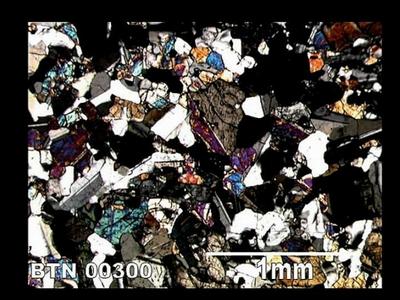
Photograph of a polished thin section in polarized light. This Achondrite meteorite is called a Eucrite, which is similar to earth basalts. (Photo by Gretchen Benedix, Smithsonian Institution)
Contact the TEA in the field at
.
If you cannot connect through your browser, copy the
TEA's e-mail address in the "To:" line of
your favorite e-mail package.
|
